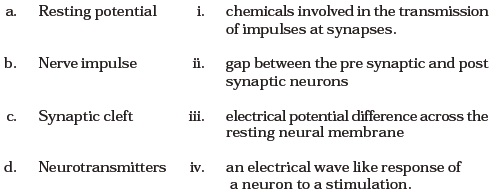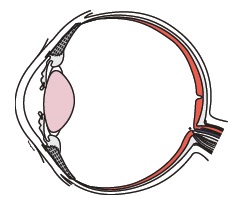Class 11 Important Questions for Biology – Neural Control and Coordination
NCERT Exemplar Class 11 Biology is very important resource for students preparing for XI Board Examination. Here we have provided NCERT Exemplar Problems Solutions along with NCERT Exemplar Problems Class 11.
Question from very important topics are covered by NCERT Exemplar Class 11. You also get idea about the type of questions and method to answer in your Class 11th examination.
Here you can get Class 11 Important Questions Biology based on NCERT Text book for Class XI. Biology Class 11 Important Questions are very helpful to score high marks in board exams. Here we have covered Important Questions on Neural Control and Coordination for Class 11 Biology subject.
Biology Important Questions Class 11 are given below.
Multiple Choice Questions
- Chemicals which are released at the synaptic junction are called
- a. Hormones
- b. Neurotransmitters
- c. Cerebrospinal fluid
- d. Lymph
- Potential difference across resting membrane is negatively charged. This is due to differential distribution of the following ions
- a. Na+ and K+ ions
- b. CO3++ and CI– ions
- c. Ca++ and Mg++ ions
- d. Ca+4 and CI– ions
- Resting membrane potential is maintained by
- a. Hormones
- b. Neurotransmitters
- c. Ion pumps
- d. None of the above
- The function of our visceral organs is controlled by
- a. Sympathetic and somatic neural system
- b. Sympathetic and para sympathetic neural system
- c. Central and somatic nervous system
- d. None of the above
- Which of the following is not involved in Knee-jerk reflex?
- a. Muscle spindle
- b. Motor neuron
- c. Brain
- d. Inter neurons
- An area in the brain which is associated with strong emotions is
- a. Cerebral cortex
- b. Cerebellum
- c. Limbic system
- d. Medulla
- Mark the vitamin present in Rhodopsin
- a. Vit A
- b. Vit B
- c. Vit C
- d. Vit D
- Human eyeball consists of three layers and it encloses
- a. Lens, iris, optic nerve
- b. Lens, aquous humor and vitreous humor
- c. Cornea, lens, iris
- d. Cornea, lens, optic nerve
- Wax gland present in the ear canal is called
- a. Sweat gland
- b. Prostate gland
- c. Cowper’s gland
- d. Sebaceous gland/ ceruminous gland
- The part of internal ear responsible for hearing is
- a. Cochlea
- b. Semicircular canal
- c. Utriculus
- d. Sacculus
- The organ of corti is a structure present in
- a. External ear
- b. Middle ear
- c. Semi circular canal
- d. Cochlea
Very Short Answer Type Questions
- Rearrange the following in the correct order of involvement in electrical impulse movement-
Synaptic knob, dendrites, cell body, Axon terminal, Axon - Comment upon the role of ear in maintaining the balance of the body and posture.
- Which cells of the retina enable us to see coloured objects around us?
- Arrange the following in the order of reception and transmission of sound wave from the ear drum:
Cochlear nerve, external auditory canal, ear drum, stapes, incus, malleus, cochlea. - During resting potential, the axonal membrane is polarised, indicate the movement of +ve and –ve ions leading to polarisation diagrammatically.
- Name the structures involved in the protection of the brain.
- Our reaction like aggressive behaviour, use of abusive words, restlessness etc. are regulated by brain, name the parts involved.
- What do grey and white matter in the brain represent?
- Where is the hunger centre located in human brain?
- Which sensory organ is involved in vertigo (sensation of oneself or objects spinning around)?
- While travelling at a higher altitude, a person complains of dizziness and vomiting sensation. Which part of the inner ear is disturbed during the journey?
- Complete the statement by choosing appropriate match among the following –

Short Answer Type Questions
- The major parts of the human neural system is depicted below. Fill in the empty boxes with appropriate words.

- What is the difference between electrical transmission and chemical transmission?
- Neural system and computers share certain common features. Comment in five lines. (Hint: CPU, input-output devices).
- If someone receives a blow on the back of neck, what would be the effect on the person’s CNS?
- What is the function ascribed to Eustachian tube?
- Label the following parts in the given diagram using arrow.

- a. Aqueous chamber
- b. Cornea
- c. Lens
- d. Retina
- e. Vitreous chamber
- f. Blind spot
Long Answer Type Questions
- Explain the process of the transport and release of a neurotransmitter with the help of a labelled diagram showing a complete neuron, axon terminal and synapse.
- Name the parts of human forebrain indicating their respective functions.
- Explain the structure of middle and internal ear with the help of diagram.
| « Previous | Next » |
Answers to Multiple Choice Questions
| 1- b; | 2- a; | 3- c; | 4- b; | 5- c; | 6- c; |
| 7- a; | 8- b; | 9- d; | 10- a; | 11- c |
Class 11 Important Questions for Biology all topics
Biology Important Questions Class 11 are given below chapter wise.
- The Living World
- Biological Classification
- Plant Kindom
- Animal Kingdom
- Morphology of Flowering Plants
- Anatomy of Flowering Plants
- Structural Organisation in Animals
- Cell: The Unit of Life
- Biomolecules
- Cell Cycle and Cell Division
- Transport in Plants
- Mineral Nutrition
- Photosynthesis in Higher Plants
- Respiration in Plants
- Plant Growth and Development
- Digestion and Absorption
- Breathing and Exchange of Gases
- Body Fluids and Circulation
- Excretory Products and their Elimination
- Locomotion and Movement
- Neural Control and Coordination
- Chemical Coordination and Integration
Other Study Material
Go Back to Biology Home Page Physics Chemistry Maths
To get study material, exam alerts and news, join our Whatsapp Channel.

